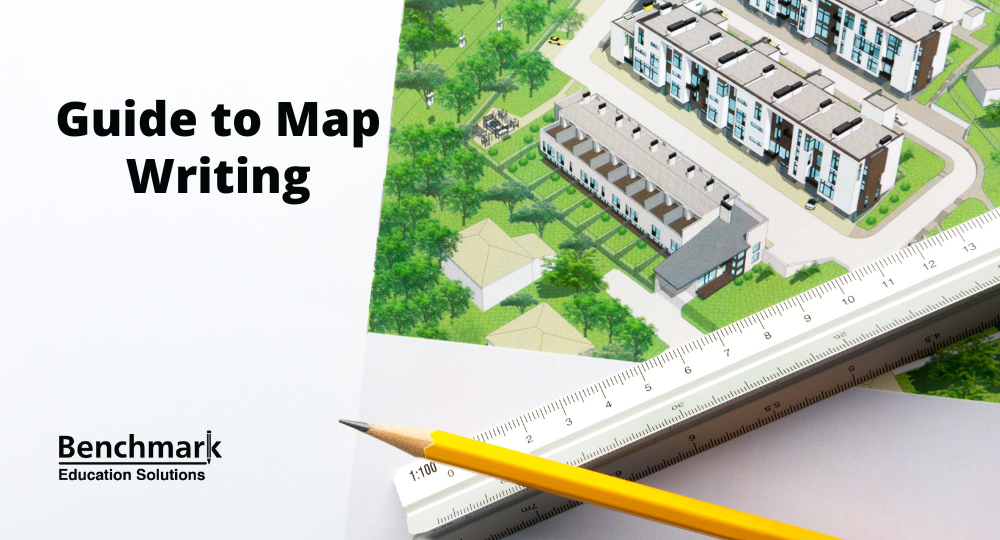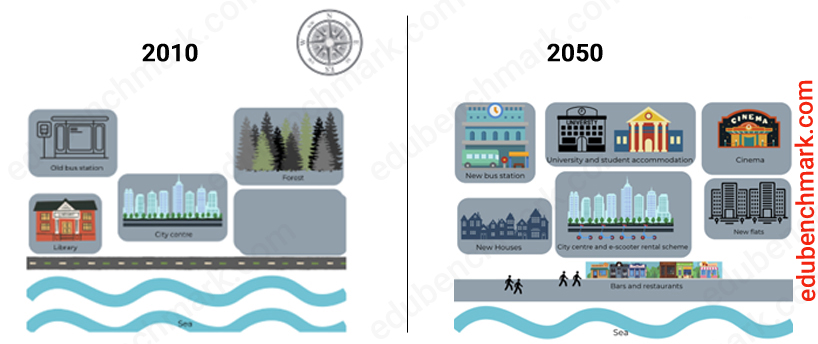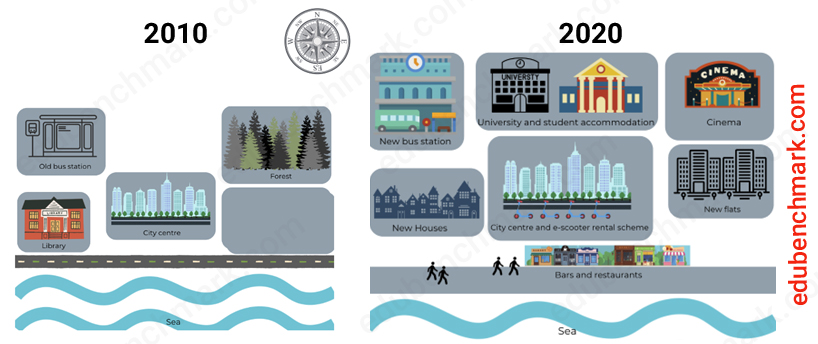

This guide will help you with IELTS map chart task 1 with sample questions and tips designed to achieve full marks in the IELTS Academic writing task 1.
Table of Contents
1. IELTS Map Overview
Maps are not a very common IELTS writing task 1 question for academic module. In this type of question, you will be given two or three maps and asked to describe the main changes that can be seen in different time periods (past, present or future). Each IELTS map will show a simplified diagram of the same fictional city or place and the changes that have occurred over time.
1.1 Objective
You have to write a 150-word formal task 1 report that summarises and compares the most important changes you see in the maps. You should produce your report in 20 minutes in the exam.
1.2 Skills Used
You are being tested on the same skills for each writing task 1. You need to:
- Produce a report using a formal register
- Report and summarise the key features of the maps
- Describe and compare any changes
2. IELTS Task 1 Map Questions
You will always be given more than one map so that you can compare the diagrams. You may be given two or even three maps that show changes in the same city or place in the past, present and/or future.
Here are some examples:
2.1 Two Maps- One in the Past and One in the Present
The maps below describe the main changes which have happened in the city of Oakville between 2010 and today.
Summarise the information by selecting and reporting the main features and make comparisons where relevant.


2.2 Two Maps- One in the Present and One in the Future
The maps below describe the main changes that are predicted to happen in the city of Oakville between 2010 and 2050.
Summarise the information by selecting and reporting the main features and make comparisons where relevant.


2.3 Two Maps- Two in the Past
The maps below describe the main changes that happened in the city of Oakville between 2010 and 2020.
Summarise the information by selecting and reporting the main features and make comparisons where relevant.


3. Structure for IELTS Map Questions
Your IELTS report should follow a clear and logical structure. The following sections will help you produce an excellent introduction, overview and main body paragraphs for an IELTS map in Academic Task 1 .
3.1 Introduction
You only need to write one or two sentences for your introduction. All you have to do here is paraphrase the given statement and briefly mention any other important features of the maps.
Here are some possible ways to start your introduction:
- The two/three maps highlight
- The maps illustrate
- The maps show…
When you are paraphrasing, you do not need to change every word. However, you should aim to use synonyms, similar expressions and change the word order when it is appropriate to produce a sentence with the same meaning.
Here is an example of a well paraphrased statement for an IELTS map question:
Original statement:
The maps below show the main changes which have happened in the city of Oakwood from 2010 to the present day.
Paraphrased statement:
The maps highlight the key developments that have taken place in Oakwood, between 2010 and today.
Main Changes:
The maps below show…
The maps highlight…
…the main changes…
…the key developments…
…which have happened…
…that have taken place…
…from 2010 to the present day…
…between 2010 and today…
3.2 Overview
After your introduction, you must include an overview paragraph. This is where you summarise the main features of the maps (without going into too much detail). This paragraph is very important to help you do well in ‘Task Achievement’.
Here is a summary of what to include in your overview for IELTS map questions:
- Start your overview with ‘Overall…’ , ‘In summary,… or ‘To summarise…’ to make it easy for the examiner to locate your overview
- Identify general changes that have happened over time
- Consider if the city or place has become more modernised; more urban; more industrial; more attractive for tourists
- In general, what has been added or removed, e.g., are there more facilities or less green spaces?
- Make sure to use an appropriate tense (e.g. if the map is in the present day, use the present tense)
3.3 Main Body Paragraphs
After your more general overview, you can go into detail about the maps in your main body paragraphs.
Consider the following points when writing your main body paragraphs:
- Make sure to use a range of correct tenses ( see Grammar for IELTS Writing Task 1 Map )
- Select between six and eight important changes to write about
- Include the year when referring to each map
- Use linking phrases for maps to introduce different areas of the city
- Include the main changes relating to: things that have been made bigger/smaller; been added; taken away; changed into something different
- Consider changes that relate to: transport; infrastructure; industry; buildings; size; location
- Include the location of the changes on the map (e.g., did the changes happen in the North, South-East etc.)
4. IELTS Writing Task 1 Band Descriptors Explained
Check out our section on IELTS Writing Band descriptors in our IELTS writing Task 1 Masterclass for helpful hints.
5. Vocabulary for IELTS Maps
5.1 Verbs to Describe Changes in Maps
Here are some common verbs that are useful when describing different types of changes in maps:
| Bigger | Add | Take away | Changes |
|---|---|---|---|
| Extend | Open | Demolish | Make into |
| Expand | Introduce | Take Away | Redevelop |
| Enlarge | Erect | Remove | Modernise |
| Add to | Construct | Pull down | Replace |
| Develop | Build | Knock Down | Convert |
| Grow | Boost | Dismantle | Make into |
5.2 Noun Phrases
You can also convert many of the verbs above to nouns to describe changes in maps using the structure the + noun + of + noun. For example:
| Verb | Noun | the + noun + of + noun |
|---|---|---|
| Introduce | Introduction | The introduction of shared bikes… |
| Modernise | Modernisation | The modernisation of the bus station… |
| Expand | Expansion | The expansion of the library |
| Redevelop | Redevelopment | The redevelopment of the city centre |
| Pedestrianise | Pedestrianisation | The pedestrianisation of the city… |
| Extend | Extension | The extension of the road… |
| Remove | Removal | The removal of the old train station… |
| Convert | Conversion | The conversion of offices to flats… |
5.3 Language to Describe Location
To give accurate information about the maps, you need to include the location in which the changes have occurred. For example:
Compass directions (if the map has a compass)
- If we look at the south of the city…
- Regarding the north-west of the city…
- …to the east of the city…
- To the west of the river…
- … on the north/south/east/west side of the river…
Top/Bottom or Left/Right (if the map does not have a compass)
- In the top right hand corner of the map
- At the bottom left…
5.4 Linking Phrases for Change
If you are using the construction the + noun + of + noun you need to introduce it with a linking phrase to complete the sentence. For example:
- The last few years have seen the conversion of offices to flats.
- One noticeable improvement is the redevelopment of the city centre.
- One significant change is the modernisation of the bus station.
- A further change is the extension of the road.
- An interesting development is the pedestrianisation of the city
- Another change has been the expansion of the library
- One change has been the introduction of shared bikes.
- A significant development is the removal of the old train station.
5.5 Linking Phrases to Introduce Areas
To develop cohesion in your report you can use linking phrases to introduce areas such as:
- If we look at the north/south/east/west of the city…
- Regarding the top/bottom of the map…
- As regards the city centre…
6. Grammar for IELTS Writing Task 1 Map
6.1 Present Perfect Passive
The present perfect passive can be used to describe changes in a map between a time in the past and now.
To form the present perfect passive, follow this structure:
Object + have/has + been + past participle
Example:
The trees in the city centre have been cut down and a new bus station has been built in their place.
6.2 Past Simple Passive
The past simple passive is useful to describe changes in two maps that both occur in the past. You can not use the present perfect passive in this case as the time period is finished in the past.
To form the present simple passive, follow this structure:
Object + was/were + past participle
Example:
The trees in the city centre were cut down and a new bus station was built.
6.3 Past Perfect Passive
If you are describing two maps in the past, you can also discuss the date that something happened with the past perfect passive.
Example:
In 2010, there were many trees in the south of the city, but by 2020, they had been cut down and replaced by a new bus station.
6.4 Relative Clauses
A relative clause is a type of complex sentence. Using a range of complex and simple sentences correctly can help to increase your score in Grammatical Range and Accuracy in IELTS writing task 1.
To form a relative clause, you need to use a relative pronoun.
Here are some examples of relative pronouns and how you can use them in an IELTS map question:
| Relative Pronoun | Usage | Example |
|---|---|---|
| That | Refers to animals and things | The building that was located in the top right corner of the map was demolished. |
| Which | Refers to animals and objects | The old bus station, which used to be located in the south of the city, has been torn down. |
| Where | Refers to places | The place where the bank was located in 2000 changed in 2010, from the north to the south respectively. |
7. IELTS Writing Task 1 Map Sample Answer
The maps below describe the main changes which have happened in the city of Oakville between 2010 and today.
Summarise the information by selecting and reporting the main features and make comparisons where relevant.


The two maps highlight the main developments that have taken place in the coastal city of Oakville, over the period between 2010 and today.
Overall, what stands out from both maps is that Oakville has become far more developed and modern, with more accommodation, amenities and entertainment facilities, and fewer trees and green spaces.
In detail, if we look at the north of the city, one change has been that the forest in the north-east has been cut down and a cinema has been constructed in its place. In 2010, there did not used to be a university and student accommodation, but today these buildings have been erected in the north of the city. As regards the city centre, the past years have seen the introduction of an e-scooter rental scheme, making it easier for people to travel around the city centre without producing emissions.
Regarding the south of the city, a significant change is the conversion of the library in the south-west into new houses. Furthermore, new flats have also been built in the south-east of the city which could have become a green space in 2010. A further important development is the pedestrianisation of the road near the sea. Bars and restaurants have also been opened along the coast, meaning that this area is now nicer to visit for residents and tourists.
7.1 Sample Answer Commentary
The report above would receive an estimated 9.0 overall in the IELTS writing task 1 Academic paper.
The overview paragraph has been clearly signposted using ‘overall’ and the key features introduced with the phrase ‘what stands out’.
A range of linking devices have been used successfully such as ‘in detail’, ‘as regards the city centre’, ‘regarding the south of the city’, ‘furthermore’ and ‘a further important development’.
Further details have been given in the main body paragraphs using vocabulary to describe location, e.g., ‘in the north-east’, ‘in the north of the city’ and ‘in the south-east of the city’.
A range of passive tenses have been used throughout the report, e.g., ‘these buildings have been erected’ and ‘bars and restaurants have also been opened’.
8. Common Errors and How to Avoid Them
Problem 1
Using the wrong tenses to describe changes in the maps.
Solution 1
Take a moment to understand what time periods you are comparing. If you are comparing a map from the past and a map from ‘today’, then the present perfect passive is useful as you are comparing changes from the past to the present. The present perfect passive would not be suitable when comparing two maps in the past. See Grammar for IELTS Writing Task 1 Map
Problem 2
Not describing the location or date of each map.
Solution 2
To improve your score in task achievement, you need to make it clear to the examiner what map you are referring to. Make sure to include the year of the map or ‘today’ for maps in the present. You should also use vocabulary to describe the location of the map feature you are referring to See Vocabulary for IELTS Maps
9. Quiz- Check Your Understanding
Take this short quiz to test your understanding of writing task 1 and maps:







Thanks for these and I’m happy now because I have learnt some useful tips which relatide ilets writing task1 maps ))